


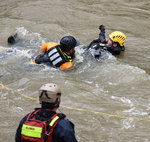
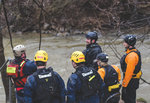
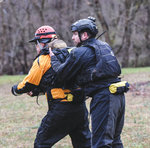
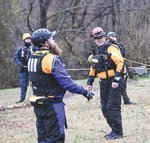
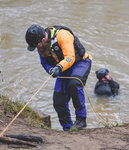


It was a cold, wet, rainy day as members of the North Chatham, Pittsboro, and South Orange swift water rescue teams prepared to enter the chilly Haw River at Saxapahaw for training.
“If it ain’t rainin’, we ain’t trainin,’” Lt. Eddie Freeman said.
Freeman is a member of the North Chatham Fire Department, the North Chatham Swift Water Rescue Team, and is an instructor for swift water rescue training. His career stretches beyond three decades and in that time Freeman has acquired a wealth of experience and knowledge — and some pretty good stories.
The North Chatham Department averages about two or three swift water rescues per year. The calls are what they call low frequency, high risk. These rescues may only account for less than one percent of the calls the fire department answers, but they also some of the most dangerous. Rescuers may be called to help someone on a raging river in Chatham County, or beyond.
“If they call us, we’ll come,” Freeman said.
The teams work together, backing each other up. The North Chatham team works with teams in Durham, Orange, Apex, Alamance, and Lee County’s burgeoning team.
“We work really close together,” Freeman said. “We have back-up people so we don’t have to do it by ourselves. We always have two teams for a rescue.”
Pittsboro’s Fire Department is also currently building a Swift Water Rescue team. Chief Daryl Griffin of the Pittsboro Fire Department was previously on the swift water rescue team at North Chatham before moving to Pittsboro. He’s been working for several years to develop a team there.
“We’ve been buying equipment for two years,” Griffin said. “We’re in training mode. We’re not going to get ourselves into any trouble until we feel comfortable.”
North Chatham Fire Department currently has 37 career and volunteer firefighters who are certified for swift water rescues, with 17 who are considered advanced qualified. The team also include two instructors, Freeman and Lt. Eric Solomon.
On the last weekend in February, close to a dozen men and one woman were in Saxapahaw to work on getting certified, recertified or simply keep their skills up for swift water rescue. The students donned special dry suits that keep the water off their skin. The gear is designed to allow the rescuers to spend long periods in cold water. Training in the winter gives the students the experience needed to work in any conditions.
“We’ve been out in the snow before,” Freeman said. “I’ve had to break ice in the river before just so we could get in.”
Each swift water rescue squad member has specially design personal flotation devices with pouches where they carry equipment. This includes carabiners, pulleys, anchor straps, a whistle, and even some snacks.
They also have a throw bag which is a bag that holds a rope that is connected to it. It’s a fundamental tool for a rescue member and a lifeline for a victim. They can be used to toss to a victim, connected to stretch across a river, and even used to stabilize a victim who may be stuck in the water and keep their head up.
“You’ve got to be accurate,” Nate Montminy of South Orange Rescue said to the students. “You have to think about how big they are, how swift the water is. You can always wrap it around a tree so the tree takes the force and helps hold the victim.”
The students were taught how to deal with victims in a crisis, practicing drills before even stepping foot in the water. The students were instructed to tell the victims to “look at me,” “rope, rope, rope” when throwing the bag, and which shoulder the victim should place the rope to ensure they are pulled to the shoreline without pulling the rescuer with them.
“They will be in a panic.” Montminy said. “You’re going to have to tell them everything you want them to do. This could be their last chance before they head downstream.”
After their drills on dry land, the group headed to the Haw River. Their first task was to practice swimming in the current, using specific techniques to get to specific locations near the bank from which they can stabilize themselves to mobilize a rescue.
“Read the location,” Freeman said. “Don’t get tunnel vision on the victim.”
Freeman talked the students through the different aspects of the water such as understanding currents, rapids, and any eddy that may form in the water.
“My first task is to introduce them to the water,” Freeman said. “There’s energy that the river can give you. You can either use it or be abused by it.”
After swimming from shore to shore multiple times, the group was ready to practice simulated rescues. They performed several different techniques and drills. The first was called “live bait.”
The students took turns playing rescuer and victim. A “victim” enters the water upstream, floating down where the rescuer has positioned themselves to attempt to save the person.
The rescuer uses a carabineer to attach a rope to themselves. Another member uses a belay technique to wrap the rope around themselves with a third rescuer holding the second to prevent them from being pulled down the river.
Further downstream, Freeman was waiting on the shore where the victims and rescuers would eventually end. His role was that of a “safety,” a last ditch effort to save the rescuer if something goes wrong.
Fortunately, all the “victims” who practiced the live bait were rescued. However, the exercise wasn’t without its own dangers. Twice the weight of the rescuer and victim pulled the teams on the shore, disengaging the rocks they were using the stabilize themselves. Though bruised and battered, and with a tear in one dry suit, the students soldiered on.
The second drills were called “contact” rescues. In this scenario, rescuers swam to the victims, and then swam the two to the shore. This is where the lone female student’s abilities really shone.
At 29, Carly Sherrod of the South Orange Rescue Squad is one of the youngest members of the team. At about five feet tall, Sherrod is also the smallest. She has been a certified member of the team for years. She is also a member of the rope rescue team, a group that is trained in rappelling into deep crevices to secure and extract a victim.
“When you’re doing rope work, it helps if the rescuer is small,” Freeman said. “Not only can they get into tight spaces, but it’s a lot less weight when you’re pulling someone out.
As Sherrod spotted the 200 pound victim, she shouted “Look at me, look at me.” As he approached, she jumped toward the victim, snatching him and securing him to herself with her legs and arms.
“Keep calm,” she said in a controlled tone. “ I’ve got you. Ok, now in a second, we’re going to roll jump a little on our left and I’m going to need to start kicking.”
sing the victim’s kicking motion and her one arm that wasn’t securing the victim, Sherrod made her way to the shore, victim in tow.
After a full morning of drills, the group broke for a well-earned lunch. The break was necessary not only to provide the team with sustenance, but to ensure that their body temperatures had a chance to warm back up.
Afterward, the team walked back down toward the river, donned their gear again, each checking their fellow students’ gear, and filed back into the river. The temperatures were dropping and the morning rain made the river water even colder than before.
As the students made their way into the frigid water, the cold and exhaustion could be seen on their faces. But this did not stop them. Soon they were coordinating the afternoon’s drills, each member participating in setting up the exercises.
With ropes anchored to either side of the shore, the students took turns on the zipline, only to have to swim back across the river to try again.
Some of the drills were meant to acclimate the students to treacherous water conditions. For example, each was suspended in the water using a pulley on the zipline in the middle of the river. As they hung there, water flowed over their heads. They held there until the whistle blew, signaling them to release. The goal was to make them comfortable in dangerous situations so they remain calm.
The instructors emphasize that each rescuers’ number one job is to survive and make it home to their families. Freeman said in terms of priority of saving, yourself is first, your team is second, and the victim is third, because “without the first two, you can’t save the third.”
“The big thing is to be able to save themselves when things go wrong,” Freeman said.
Freeman shies away from the spotlight, but with decades of experience and stories, and being just a few years to retirement, his legacy should be shared. He’s a second-generation firefighter.
“I grew up around helping people you don’t know,” he said.
When Freeman started with the North Chatham team, the group wore wet suits which don’t protect from the elements and the cold, and had mostly whitewater rafting equipment. Over the years, he built the team to what it is today.
He even saved a cow once.
About five years ago, the team was called to rescue some kayakers near Chicken Bridge. At the same time, they got a call about a cow that was stuck. Animal rescues are not what the team normally addresses, but this time they did.
They could see the cow’s head, but the rest of him was stuck in the mud. It would have died had the teamed not intervened. They had to call in a wrecker to pull the animal out.
The fire department was using new radio equipment at the time. Freeman had thought that he had a private line to his team when it radioed “I’ve rescued a cow and a kayaker on the same day.” Shortly after he heard over the radio, “Central…copy… saving cows and kayakers all on the same day.” Freeman has never lived the moment down.
“You see some crazy stuff on the river,” Freeman said. “The water environment is dynamic, it’s relentless.”
And then there was the time when Freeman almost had to be rescued on the river. Almost a decade ago, Freeman was at home when he received a call for a rescue of three people who lost their canoe on the river, which was a mere six inches from flood stage. He joined members of North Chatham and Apex, his being the safety boat.
That day, his boat hit something hard in the river. Then it hit something else, causing the engine to stop. He didn’t know it at the time, but something had hit the engine hard enough to bend it. The motor boat suddenly became a row boat.
“It was the first time in 35 years I ever had to make a mayday,” he said.
With the primary boat out of position to give aid, the safety boat navigated rapids before being dragged under a tree that had fallen across the channel.
The tree hit Freeman in the chest, knocking him out of the boat. Another firefighter was left clinging to the tree with only one person left in the boat.
“I knew I needed to get back into boat,” he said. “It was probably record time, I was very motivated.”
The original team had rescued the civilians and the team called in South Orange Rescue to assist in getting the member stranded on the tree. They made their way to shore and hiked back to safety.
The episode earned all the team members the Higgins & Langley award 2012, an international award for first responders.
It’s because all the teams worked together,” Freeman said. “It’s not what one person did. It’s because everybody did it right. It’s because of everyone’s training.”
Freeman will likely retire in the next few years. He has been working to train Solomon to be able to instruct in his stead.
“Nobody is so important they can’t be replaced,” Freeman said. “It would be rude to not train somebody to take that position. But if you’re important you need to make sure somebody can take your place.”
If you’re interested in joining one of Chatham County’s Fire Departments or their Swift Water Rescue Teams contact either Chief John Strowd or Deputy Chief Mark Riggsbee at 919-542-3380.
Other items that may interest you
